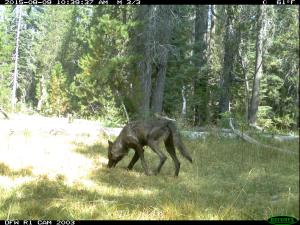CDFW Creates Wolf Conservation Plan
The following is a press release from the California Department of Fish and Wildlife:
The California Department of Fish and Wildlife (CDFW) has released the draft Conservation Plan for Gray Wolves in California and is soliciting input about the draft.
The plan is the product of collaboration between CDFW scientific and wildlife experts, and a diverse stakeholder group that has spent many hours since 2012 to develop it. The group includes Rocky Mountain Elk Foundation, Natural Resources Defense Council, California Farm Bureau Federation, Defenders of Wildlife, California Woolgrowers Association, California Deer Association, California Cattlemen’s Association and the Center for Biological Diversity, among others.
Interested parties are encouraged to review CDFW’s website with information about gray wolves in California, including the legal status of wolves under federal and state law, the migration of the first documented wolf in the state in nearly 100 years and CDFW’s announcement about the Shasta pack this summer. The website also features procedures for contacting CDFW for those who may experience wolves in the wild.
Informational workshops will be held to provide information and hear views about the plan in early 2016. All meetings will be held from 5-8 p.m. Dates and locations are as follows:
- Yreka: Jan. 21, 2016
Miner’s Inn Convention Center/Best Western
122 E. Miner St., Yreka 96097
- Long Beach: Jan. 26, 2016
Pointe Conference Center at CSU Long Beach
Walter Pyramid (entrance on Merriam Way)
1250 N. Bellflower Blvd., Long Beach, 90840
- Sacramento: Feb. 1, 2016
Double Tree Hotel
2001 Point West Way, Sacramento, 95815
Comments will also be accepted via e-mail atwolfplan@wildlife.ca.gov, and regular mail at:
Wolf Plan Comments
P.O. Box 26750
San Francisco, CA 94126
Please postmark the comments no later than Feb. 15, 2016.
The San Francisco Chronicle‘s Peter Fimrite weighed in on the report’s release:
The conservation plan emphasizes the use of nonlethal methods to control wolves, including those sneaking onto ranches to attack sheep and cattle. But flexibility is built in so that, as the population grows, new techniques can be used to avoid conflicts, said Jordan Traverso, a fish and wildlife spokeswoman.
“We think we’ve presented a pretty solid plan, but we will look to continue the process with the stakeholder group and the public to help us make something more final,” Traverso said of the draft plan, which will be open for public comment until Feb. 15, 2016.
“The fact that wolves have come back after nearly 100 years is a really great ecological story,” she said. “It’s really exciting, and it’s also kind of scary for a lot of people. There isn’t a lot of historical knowledge from the time when wolves were here last, so there is a lot to be learned.” …
… Wolves have long been expected to migrate into California, but the journey a few years ago of OR-7 — so named because he was the seventh wolf to be radio-collared in Oregon — created an international sensation. The lone wolf left the Imnaha Pack in Wallowa County, Ore., in 2011 and traveled an estimated 2,500 miles through Siskiyou, Lassen, Shasta, Modoc, Butte and Plumas counties.
The remarkable journey was, for the most part, the impetus for the creation of the state’s wolf plan.




